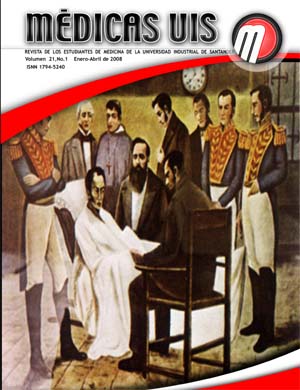Resumen
La holoprosencefalia es una de las más graves y la más común de las malformaciones cerebrales y faciales; consiste en la diverticulación nula o incompleta del prosencéfalo embrionario hacia los hemisferios cerebrales y ventrículos laterales; se acompaña de defectos en las estructuras de la línea media como boca y nariz, es de aparición temprana en el desarrollo del sistema nervioso central y ocurre como consecuencia de una posible falla en un conjunto de moléculas, que incluyen la proteína Sonic Hedgehog y a la superfamilia de genes BMP, indispensables para la formación normal del encéfalo; además, se ha asociado con anomalías en los cromosomas 13, 3, 7 y 18. Hasta el momento, el diagnóstico y clasificación es anatomo-patológico. Se describen dos casos de la variante semilobar diagnosticados por ecografía, y posteriormente por necropsia. El objetivo de este artículo es exponer dichos casos y hacer una breve descripción del mecanismo fisiopatológico implicado.
Palabras clave: Holoprosencefalia. Aberraciones cromosómicas. Paladar fisurado.
Referencias
2.DeMyer W, Zeman W, Palmer C. The face predicts the brain, diagnostic significance of median facial anomalies from holoprosencephaly (arhinencephaly). Pediatrics. 1964;34:711-8.
3.Dubourg C, Bendavid C, Pasquier L, Henry C, Odent S, David V. Holoprosencephaly. Orphanet J Rare Dis. 2007;2(2):8.
4.Towards a greater understanding of the pathogenesis of holoprosencephaly. Brain & Development.1999;21:513-21.
5.Biancheri R, Rossi A, Tortori-Donati P, Stringara S, Bonifacino S, Minetti C.Middle interhemispheric variant of holoprosencephaly: A very mild clinical case. NEUROLOGY. 2004;63:2194-6.
6.Olsen Carolyn L, Hughes Jeffery P, Youngblood Lois G, Sharpe-Stimac Monica. Epidemiology of Holoprosencephaly and Phenotypic Characteristics of Affected Children: New York State, 1984–1989. American Journal of Medical Genetics. 1997;73:217–26.
7.Roessler E., Muenke M. Holoprosencephaly: A paradigm for the complex genetics of brain development. J. Inher. Metab. Dis. 1998.
8.Moore, k.l. y Persaud, T.V. Embriología clínica séptima edición. Mc. Graw Hill, Philadelphia, Pennsylvania, USA, 2006.
9.Monuki ES. The morphogen signaling network in forebrain development and holoprosencephaly. J Neuropathol Exp Neurol. 2007;66(7):566-75.
10.Ten Donkelaar HJ. Major events in the development of the forebrain. Eur J Morphol. 2000;38(5):301-8.
11.Cohen MM Jr, Shiota K. Teratogenesis of holoprosencephaly. Am J Med Genet. 2002.15;109(1):1-15.
12.Muenke M, Beachy PA. Genetics of ventral forebrain development and holoprosencephaly. Curr Opin Genet Dev. 2000;10(3):262-9.
13.Nanni L, Schelper RL, Muenke M. Molecular genetics of holoprosencephaly. Frontiers in Bioscience. 2000:334-42.
